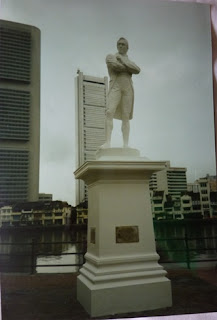Singapore was a British colony when LKY was born. He became prime minister in 1959 with the People's Action Party (PAP). Singapore then became part of the Malayan Federation in 1963 and Malaysia was created. However in 1965 Singapore was expelled by Tunku Abdul Rahman of Malaysia. This year Singapore will celebrate 50 years of independence.
Under LKY Singapore was able to stand on it's own two feet and do so well, despite having no natural resources. For decades it had to buy water from Malaysia.
I've known Singapore for almost 26 years, having first visited in 1988. In those 2.5 decades I have seen the incredible transformation that has taken place. In the 1990s I used to visit Singapore regularly as it was still cheap - accommodation was cheap and it was cheap to fly from Kuala Lumpur. I also used to fly Singapore Airlines to London.
But in recent years Singapore has got so expensive. Hotels are just too expensive for me now. But I really admire how Singapore has grown and how Lee Kuan Kew made the country so successful.
I was lucky enough to know some of the old parts of Singapore. I can remember Bugis St before it totally changed. I went to Raffles before it was renovated.
In my backpacker days I stayed in the cheap hostels (crash pads) in Bencoolen St. - Air Power, Peony Mansions, Hawaii guest house, Bencoolen St Apartments aka Goh's homestay, and buy air tickets at Airmaster Travel. In those days a dorm bed was $6.
Hawaii was still around in 2004 -
I remember smelling durians for the first time in the street market near Bencoolen. I also saw my first Chinese opera on the street.
Then I progressed to more expensive Chinese hotels, Kian Hua ($25 single room), Tiong Hoa, Victoria Hotel. Many times I stayed in The Mitre Hotel in Killeny Rd, ($20). It was a wonderful old colonial house, very run down but very atmospheric and full of character and characters!
1991 views -
I was so sad when I went past in 2012 and found the house and gardens were now this monstrous building
After the Mitre I went more upmarket! New Mayfair Hotel ($33), and the Mario-Ville dance academy. In recent years I've also stayed in some of the 5* hotels!
I remember eating at Cuppage (Orchard Rd), the Paradiz Centre, Plaza Singapura, Fatty's at Albert St, the Satay Club and of course Newton Circus. I had many good Indian meals in Komala Villas in Serangoon Rd. Mum looking at a stall selling pig parts!
I often went to the cinema in a shopping centre in Beach Rd (Beach Centre?).
I used to pay many visits to the GPO at Raffles Quay, to collect my mail from poste restante. It was always nice to step into the coolness of the building. The GPO is now the luxury Fullerton Hotel.
Opposite were the famous satay stalls in the open air food court. I also paid many visits to Singapore philatelic office to buy stamps for my uncle and go to the telekom place to make phone calls back home to mum. The philatelic shop -
Change Alley was just beyond the GPO and was a good place to change money and for cheap shopping. In those days the Merlion Park was tiny.
I used to know Orchard Rd really well. Now it is almost full of tall shopping malls, hotels and office buildings.
I went to Changi prison a couple of times.
Many times I went to the swimming pool in River Valley Rd. And I would walk over the hill at Fort Canning. I also went to the national library near the YMCA and Bencoolen. I occasionally went out to the Jurong Science Centre for 3D films.
Changi Airport has won awards over the years. I used to fly to/from Pulau Tioman to Seletar Airport on Singapore.
I haven't been to Singapore zoo for years but know it is an excellent zoo, especially the night safari.
I didn't go much to Chinatown area in those days. Only went to the Haw Par House (the Aw brothers of Tiger Balm fame) once. I also went out to the Tiger Balm Gardens 10 km out of the city. I saw the Sunday morning bird singing. Only went to Sentosa once.
Singapore is nicknamed 'a fine city' because of the strict rules and laws and people are fined for breaking them - even more 'minor' things like jaywalking, littering, chewing gum etc. The best thing about Singapore is it is so efficient. Everything works, everything is clean. It is such as refreshing change to go to Singapore from Malaysia! The transport system is good, the MRT, buses and the taxis. I was a regular on the buses to JB, the 170 from Queen Stand the more direct 390.
And finally Raffles who started Singapore even before Lee Kuan Yew








r.jpg)











































